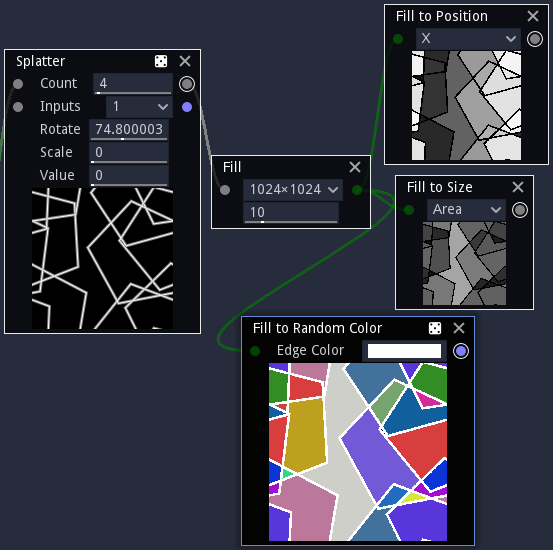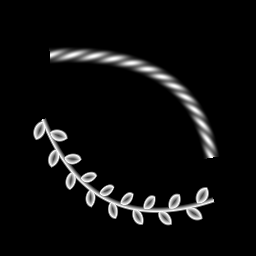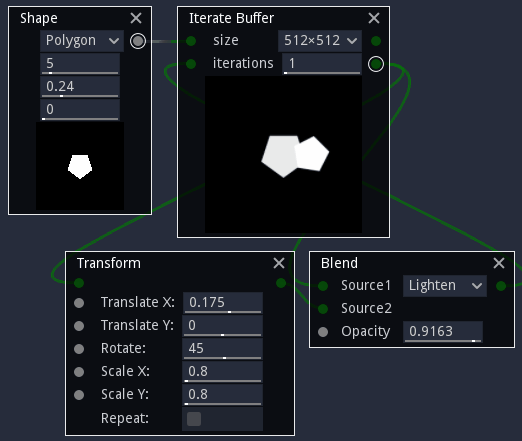Material Maker 0.92
Material Maker has been updated to 0.92, with user interface, performance improvements and quite a few new nodes. Please don't hesitate to report bugs and submit ideas for new features and new nodes for next releases on Github.
If you want to show or share the awesome materials you created, or ask (or answer) questions about the tool, you may want to join the Material Maker subreddit. It still has few members and little activity, but I'm pretty sure you (yes, you!) can contribute to changing this.
You may think that releasing 0.6, 0.7, 0.8 and 0.9, then slowing down to 0.92 (with an April Fools & experimental 0.91 release in between) is weird: yes, it is! 0.92 is just another release with many new nodes and features, and the only reason it is not called 1.0 is that Material Maker still does not have undo/redo. I have to admit I've been procrastinating this feature since the beginning (coding undo/redo is so boring...), but there will definitely not be a 1.0 release without it!
And of course, thanks a lot to everyone who contributed patches, reported bugs or suggested new features for Material Maker, showed the nice materials they created with it, or donated.
User interface
- 0.92 has all performance optimization from 0.91, without the bugs (at least without the bugs I noticed and fixed), as well as the histogram panel.
- In the 3D preview, the shader for tesselated meshes has(finally) been fixed and a new tesselated quad mesh (useful to visualize steep depth maps) has been added.
- The 2D preview pane now has a menu that can be used to select the preview type and save the preview as a PNG image file. The previews inside graph nodes also have a menu to save as PNG.
- Material Maker will now remember the directory where you loaded or saved projects, previews... No more navigating your whole hard disk whenever you want to load or save a file.
- A selected group can now be entered using the Tab keyboard shortcut and exited using Shift-Tab or Backspace.
- Themes have been tweaked a little bit and optimized (making Material Maker loading time be a bit shorter).
Export
- Unity has a new export option for HDRP, which was contributed by luggage66.
New and updated nodes
- 0.92 has the Tones node from 0.91.
- The new Fill node detects areas inside white lines from its input. Its output cannot be used directly, but can be processed by Fill companion nodes such as Fill to position, Fill to size, Fill to random color, Fill to UV... For those interested, I wrote tweets about how it is implemented a while ago.

- The new Dilate node expands white shapes from its input and can get colors from an optional secondary input. The screenshot below shows the output of the Dilate node on the Splatter image with (main preview on the right) and without (thumbnail preview of the top Dilate node) that secondary input.

- The new Math node provides quite a few operations that will apply to 2D greyscale inputs (or constant parameters defined in the node). They can be pretty useful (for example) when tweaking the parameters exposed by groups.
- All convolution nodes (blur, sharpen, normal map...) have been rewritten as shader nodes and the convolution node type is now deprecated.
- The new Curve node can be used to create simple bezier curves (defined by 3 control points), filled with an optional input texture. As many nodes that rely on tricky math formulas (mostly 2D and 3D SDF nodes to be honest), it is based on a shadertoy project by Inigo Quilez.

- The gaussian and directional blur nodes now have a new input that controls the intensity of the blur effect on the output image (see screenhot below). The blur family also has a new member, the slope blur, that is some kind of mix between a warp and a blur effect.

- Both Tiler nodes now have a parameter to define a fixed offset applied to odd lines. This makes it possible to tile their input on a hex grid. Greyscale Tiler and Splatter nodes also have a secondary output that assign a random color to each object placed on the generated output. All Splatter and Tiler nodes also have an extra random value/opacity parameter.
- New simple transform nodes (translate, rotate and scale) have been added as smaller alternatives to the Transform node. They also are slightly different since they don't clamp their result and rotate and scale transforms have a customizable center. A new Shear transform node is also available
- The Line and Arc signed distance nodes now have a width parameter.
- The new Iterate Buffer node type is a Buffer node that memorizes its input, applies a subgraph (that is between its bottom output and its bottom input) to its buffer a given number of times and outputs the result. The example below applies a simple transform to create an interesting spiral pattern. Note the Fill node relies heavily on this one.

- Buffer nodes now save their contents as a 16 bits float per pixel per channel images, so their output should be a bit (or to be more precise at least 3 bits) more accurate.
Files
Get Material Maker
Material Maker
Procedural textures authoring tool
| Status | In development |
| Category | Tool |
| Author | RodZilla |
| Tags | designer, godot-engine, material, PBR (Physically Based Rendering), Procedural Generation, substance, Textures |
| Languages | English |
More posts
- I need your help (just 2 clicks)78 days ago
- Material Maker 1.490 days ago
- Material Maker 1.4RC6Sep 21, 2025
- Material Maker 1.4RC5Aug 25, 2025
- Material Maker 1.4RC4Aug 07, 2025
- Material Maker 1.4RC3Jul 30, 2025
- Material Maker 1.4RC2Jul 12, 2025
- Material Maker 1.4 RC1Jul 03, 2025
- A third beta for 1.4Jun 11, 2025
- Material Maker 1.4b2May 09, 2025

Leave a comment
Log in with itch.io to leave a comment.